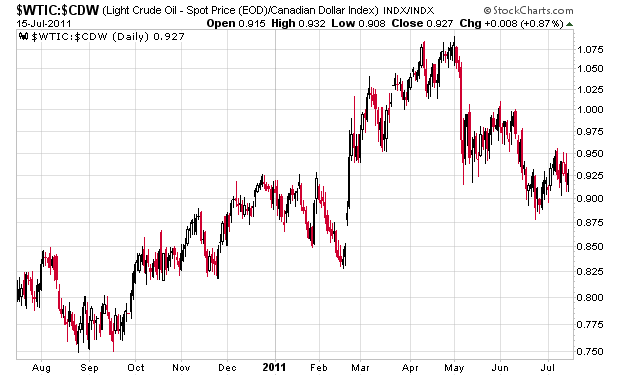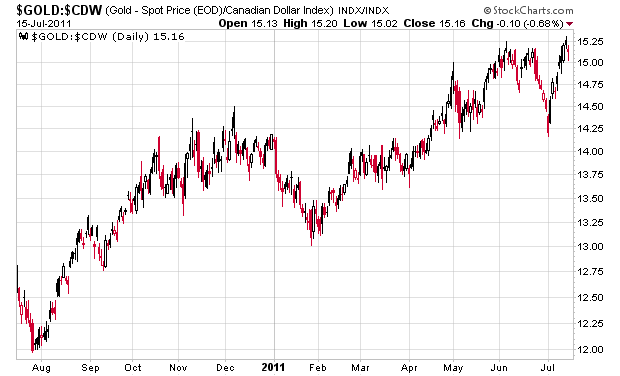This is going to be a rather disjointed post, but it will attempt to explain the psychology of losses, misconceptions and dealing with panic downturns.
What’s happening, and what will be happening?
The S&P 500 began the week at around 1300 and ended the week at around 1200, a drop of about 8%. This is the biggest downturn in the markets since the 2008 economic crisis. For anybody that began investing since March 2009, this is also the first real instance of losses (whether realized or not) that they are facing. Year-to-date, the S&P 500 is down about 5%. For Canadian investors, the TSX composite is down 10% over the past 5 days and year-to-date it is down 10%.
The cause of this market dump is not entirely clear – it is attributed to the events going on in Europe (in that Italy is the next domino to fall in the Euro debt pyramid) and also the rather lacklustre resolution to the US fiscal situation – although they bought themselves $2 trillion in permitted debt, the US government is still spending cash like a drunken sailor at a casino and they have not even come close to addressing the fundamental issues in their fiscal structure (mainly spending too much money).
These situations are not exactly unanticipated by the marketplace, but it has come to the forefront to such a point that the markets have taken swift action by jettisoning nearly everything and going into the warm and fuzzy safety of liquid AAA debt. Government bond yields have all across the board sunk to lows that have not been seen since the 2008 economic crisis. I am also of the opinion that the S&P downgrade of the US government is irrelevant. It is counter-intuitive that bonds are trading so highly when there is so much debt issued, but where you will see the future depreciation is in the currency, not the bonds – your cost of holding US bonds is paid for in currency depreciation rather than low yields.
The most frequently asked question is – is this a time to purchase stocks? My hunch is that while we will see rallies in the marketplace over the next few months, the prevailing momentum has clearly turned negative and it continues to be a time to be risk adverse. I could be wrong – this could have marked some sort of panic low and we all move up from here on in, but markets typically do not work that way – we have had a two year rally (March 2009 to 2011) that was primarily fueled by federal reserve action (QE, QE2) and now that the money spigot has run out, we are going to see a normalization of the markets.
I have managed to survive the 2000-2002 and 2008-2009 market drops with losses, but without the 60% wipeouts that the indicies took during these periods. There are a few rules that I have about these sorts of situations. One is somewhat obvious, but cash is king. If you do not have enough cash to pay for what you need (for retail investors – your expenses, for institutions – redemptions!) then the decisions you will take will be risk-adverse to the point that you will compromise your ability to obtain returns for whenever the recovery occurs. Cash is important, even when it yields nearly nothing.
Another rule is that sustained market downturns tend to go on longer than most people would otherwise anticipate. This downturn really started in April of this year, but it was only until now that there was a sharp and significant decline.
Finally, another rule of market declines is that you will see sharp rallies upward during market downtrends. These rallies are quite deceptive – they have a tenancy of sucking in money from people that feel like they are missing out, but they do not call them “sucker rallies” without a reason – they are very dangerous to participate in unless if you have an explicit objective of making a quick 5% before bailing out and realizing gains.
The Divestor Portfolio
I have made some pretty bone-headed decisions over the past couple months and as a result, I am about 9% down for the year (roughly equal to the indicies, although I do not measure myself against the indices) so I am not happy with my performance considering the amount of cash I have in my portfolio. There were a few transactions that attributed for a good chunk of the loss. I have ended the week with significant amounts of cash. There is no longer safety in anything except cash – even companies with the most ridiculously undervalued metrics (e.g. trading below book value, P/E of 8-10) are being throw out of portfolios simply because they are liquid and can be converted into cash.
Usually I am better at side-stepping these sorts of market situations. Not last Thursday, and I was very upset at my inability to doing so.
“I can’t sell because I will take a loss”
It is strange that market downturns provoke a lot of discussion amongst friends that invest. The most common mode of incorrect thinking is that “I don’t want to sell XYZ because I will take a loss.” You inquire further and you find out that some shares that they bought back in January slid 4% below their cost basis on Friday. Portfolio holdings should always be measured against current market value. The only difference that cost basis makes is the tax treatment of the disposition – there is no other reason why an investor should care about cost basis.
I find it very interesting that people cannot be psychologically programmed to ignore the concept of “selling at a loss”.
I personally find it easy to mercilessly jettison losers out of the portfolio knowing that my government will be subsidizing me for some of it when I write off the capital losses against capital gains. Sometimes you just have to raise your arms up and come to the conclusion that your analysis was incorrect and that the stock you bought for $20 is not worth nearly what you paid for it even when it trades at $17. Remember Nortel in October of 2000 when it was trading at around $130/share and then had a horrible earnings report and tanked to roughly $90? If you had bought shares of Nortel at $130 but had the market take you out for $40, maybe it is a sign that Nortel was worth far, far less and the market has not realized it yet?
This reminds me of a story that goes as follows: Let’s pretend you bought some shares of a company for $10,000. In a week from now, the shares have gone up to $100,000. Then a week later, the shares went down to $11,000. You sell the shares, and then say to yourself “Man, that was a great $1,000 I just made there!”.
The reality is that you should always be looking at the market value of what you are investing to determine whether it should be in your portfolio or not. Did this company have value at $10,000? Did this company have value at $100,000? Basic portfolio management is that while you should let your winners run, you should also take some money off the table and trim the position if the company trades above your fair value range.
Why fundamentals generally do not matter in panic downturns
Markets that experience deep and volatile downturns exhibit irrational behaviour. The reason is because equities and debt trade mostly on the basis of liquidity rather than any underlying value. As most transactions these days are conducted by algorithmic trading, liquidity is a critical provision that these programs take into consideration. Anybody displaying a bid of size on a relatively illiquid security is likely to have their orders filled in. Likewise, these algorithms also value liquidity, which is why large cap stocks tend to see more gyrations rather than a steady decline down.
In market downturns, everything gets taken out and shot, no matter how “safe” they may seem, or how ironclad their financial statements are. If you look at every equity on the Canadian and US markets, there are only a very few equities that managed to preserve their value during the 2008 economic crisis.
Yield chasing / Leverage
A lot of people are discovering why chasing yield is a painful exercise – you might pay $50 to get that $2.50 annual dividend, but it isn’t going to do you a lot of good if the capital value permanently drops to $40. With interest rates as low as they were, it seems mathematically easy to borrow money at dirt-cheap rates (e.g. US cash at 1.5%, Canadian cash at 2.5%) and invest them in preferred shares and skim the yield difference, but what happens if the capital value of those preferred shares starts to drop? Likewise, low yields have forced capital to find their way to the commodity markets – with oil dropping $10 over the past week, what will the impact be on investors in commodities and related equities?
There is a vicious circle with deleveraging – people need to sell assets to raise cash to reduce their leverage ratios. However, the act of selling forces asset prices down, which requires people to deleverage more, etc. It all usually ends up in a big purge – and we saw some of that purge happening last Thursday when the indicies dropped 5%.
Making up losses
One of the worst tenancies for gamblers is that they feel compelled to make up their losses by making heavier subsequent bets. This is a sure-fire way of losing capital because such betting is usually fuelled emotionally, plus it is done at a time that is usually unfavouble for such betting (such as in the middle of a market downturn trend).
Psychologically speaking, the tenancy to get to the break-even point is very powerful, but one must mentally realize that the capital that you have remaining doesn’t have to be deployed in the same vehicles that you lost your money with (e.g. averaging down) or just after the time the capital was lost (e.g. Thursday). Investing should be done when the conditions are ideal and right and that includes looking at the external marketplace and also inside your own head to make sure you are thinking clearly.
Real estate
I have no idea whether a sustained market downturn will impact the Canadian real estate market. However, one wonders whether the values of real estate (especially in Vancouver, one of the most over-valued real estate markets in the world, primarily due to a massive influx of capital from China) will depreciate as the “wealth effect” reverses.
Final note
I do not think this is over yet. There is a lot of baggage to be dealt with the sovereign debt situation which may not be fully appreciated or realized in the markets yet. While corporate valuations (especially in the large cap sector) appear to be ridiculously low, it is still no reason why stocks can’t still be jettisoned in the name of deleveraging and liquidity-raising. However, given my performance to date this year, I could be wrong. I certainly have been over the past few months.



